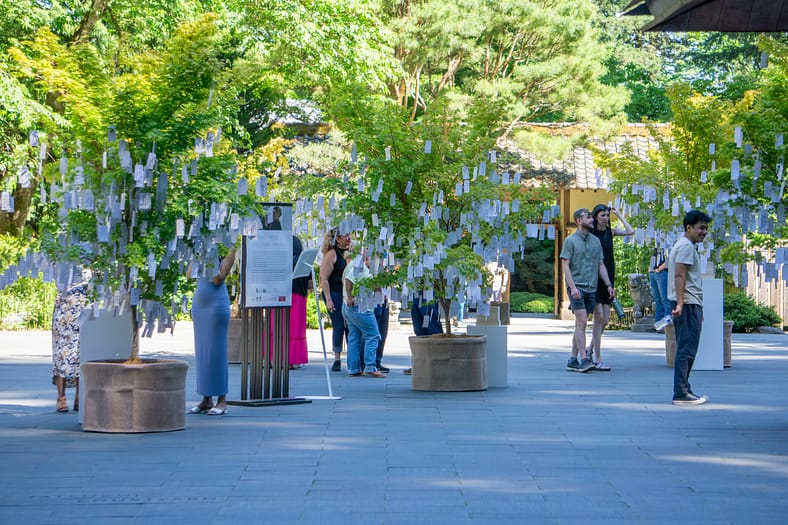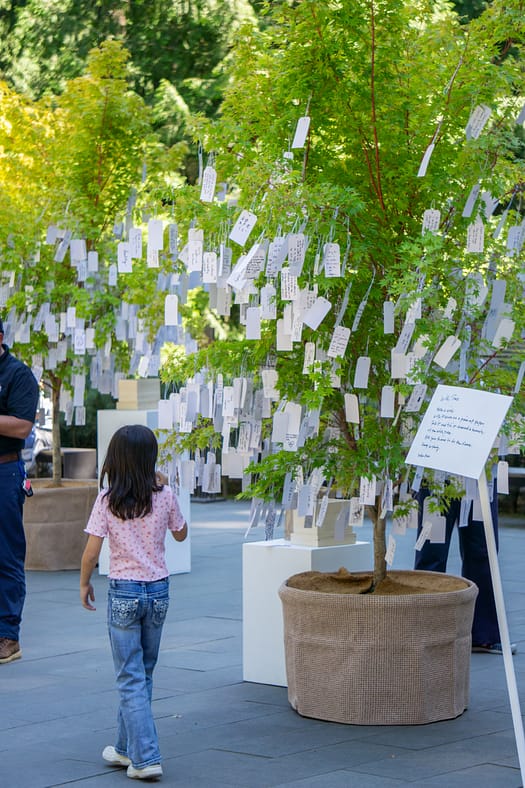
PORTLAND, Ore., United States—June 3, 2024—Led by Japan Institute of Portland Japanese Garden, an American nonprofit organization and cultural institution based in Portland, Oregon, public gardens around the world will present the collaborative installation: SPREAD PEACE: Wish Tree by Yoko Ono. The Wish Tree will show simultaneously from June 7-10 at Portland Japanese Garden in the U.S., Keihanna Commemorative Garden in Japan, Kokoro no Niwa in Chile, and Johannesburg Botanical Gardens in South Africa. This collaboration expands on the YOKO ONO: PEACE is POWER exhibition showing at the Nobel Peace Center in Oslo, Norway. SPREAD PEACE: Wish Tree by Yoko Ono in Portland Japanese Garden will be displayed in the attraction’s Cultural Village.

Yoko Ono’s interactive artwork Wish Tree invites guests to reflect and write their wishes for peace, which then get tied to the tree’s branches. Over time, the Wish Trees become adorned with these hopeful missives, evolving into a visual representation of the community’s collective aspirations for peace in our time. This interactive art, created by Ono in 1996, has collected more than two million wishes from visitors worldwide. After the installations conclude, the wishes will be returned to Ono and continue in connection with the IMAGINE PEACE TOWER in Reykjavík, Iceland. Acclaimed artist and peace advocate Yoko Ono’s artistic contributions have continued since the early 1960s. Her creative practice explores themes of love, non-violence, and human connection and is characterized by its emphasis on participatory work. Ono’s art invites visitors to engage in completing the artwork. Activating introspection, imagination, and connection, this participatory process can serve as a catalyst for personal and social transformation.

Portland Japanese Garden was founded in 1963 with the hopes that, through a public and authentically-crafted garden, the wounds of World War II could begin to heal. The Wish Tree represents what our organization has now witnessed for more than 60 years—we can bridge divides and foster dialogue through the intersection of nature, art, and cultural immersion. Through the organization’s sibling organization and global cultural initiative Japan Institute, it is honored to partner with some of the finest gardens globally, the Nobel Peace Center, and Yoko Ono’s studio in this meaningful endeavor that demonstrates how the call for peace is understood universally, although it may be expressed in many different forms.

“The Wish Tree is a suitable artistic representation of what Portland Japanese Garden stands for—the human connection with nature, art, peace and others,” comments Steve Bloom, CEO of Portland Japanese Garden & Japan Institute.
“For Yoko Ono, the message of peace and art go hand in hand,” comments Kjersti Fløgstad, Executive Director at Nobel Peace Center in Norway. “In her creative universe, people can explore their own hopes and wishes for a more peaceful world – and hope is something we really need in the time we live in.”
“As a park created to commemorate the construction of Kansai Culture and Science City, Keihanna Commemorative Park has a role as an international and local hub of exchange. We are therefore very happy that this park will be one of the relay points connecting the local with the global through the Wish Tree project,” comments Tomoki Kato, President and Representative Director of Ueyakato Landscape in Japan.
“We are convinced that the Wish Tree will deepen the values of cultural connection that inspired the creation of Kokoro no Niwa while, at the same time, bringing the community together as it expresses its dreams and wishes for peace with the world. Once in place, Wish Tree does not belong to the artist or a chosen few but rather becomes a common good that expresses shared belonging,” comments Romina Valentino Benavides, Executive Coordinador, General Management, Compañía Minera del Pacífico in Chile.
“The Wish Tree installation supports Johannesburg Botanical Garden’s efforts to foster an appreciation of nature among the local community and positively impact the landscape through reforestation,” comments Bishop Ngobeli, Manager of Protected Areas at Johannesburg Botanical Garden in South Africa.
Digital Assets

Click here for images and information. Credit instructions are provided in the Dropbox.
Media Contact
Will Lerner, Communications Manager
Portland Japanese Garden & Japan Institute
Email: wlerner@japanesegarden.org
Phone: 1-503-542-9351
More About the Participating Organizations
Portland Japanese Garden and Japan Institute
Portland Japanese Garden is a nonprofit organization founded in 1963 as a place for cross-cultural understanding following World War II. A hallmark in the City of Portland and the state of Oregon, the Garden was founded on the ideals of peace and mutual understanding between peoples and cultures. Portland Japanese Garden is considered the most authentic Japanese garden outside of Japan and among the foremost Japanese cultural organizations in the world.
Japan Institute was established in 2022 as a global cultural initiative of Portland Japanese Garden. This sibling organization is the programmatic arm of Portland Japanese Garden, allowing us to share and expand our cultural programs more broadly around the world, deepen international partnerships, and continue to engage diverse people in shared experiences and conversations about peace, beauty, and connection of nature. Japan Institute consists of three centers: Global Center for Culture and Art, International Exchange Forum, and International Japanese Garden Training Center.
Portland Japanese Garden & Japan Institute share the mission: Inspiring Harmony & Peace.
Nobel Peace Center
The Nobel Peace Center is the public face of the Nobel Peace Prize, situated in Oslo, Norway. It tells the stories of the Nobel Peace Prize laureates and their work through exhibitions, educational programmes, guided tours, and digital content. The center is also a meeting place for topical events and conferences related to peace, dialogue, and human rights. The Nobel Peace Center is located at the Oslo City Hall square, in an old train station from 1872, overlooking the harbour.
Keihanna Commemorative Park
Keihanna Commemorative Park was built as a park to commemorate the establishment of Keihanna Science City (Kansai Science City). The park’s theme is that of the “sato,” the nostalgic countryside scenery of Japan. Visitors can enjoy various areas such as the Suikei-en (Japanese garden), Mebuki-no-Mori (Budding Tree Forest) based on the countryside mountain forest, and the open area motif created after a rice paddy terrace. Keihanna Commemorative Park offers entertainment and seasonal events throughout the year.
About Kokoro No Niwa, La Serena, Chile
Kokoro No Niwa is a Japanese Garden located in La Serena Chile. It was built between 1988 and 1995 as a contribution of the Compañía Minera del Pacífico to the cultural and tourist development of the Chilean Coquimbo region. Spanning 26,000 m2, it’s Latin America’s largest Japanese garden. Its name, Kokoro No Niwa or Garden of the Heart, symbolizes the Japanese and Chilean cultures that collaborated to create it. Crafted to promote harmony and balance, it produces a purifying effect among those who visit it. The garden features walking paths, water streams, a tea house, and a Zen garden illuminated by Japanese lanterns. With over 70 plant varieties and diverse wildlife, including Koi fish, swans, turtles, and ducks, it offers visitors a serene and immersive experience.
Johannesburg Botanical Gardens
The 81-hectare Johannesburg Botanical Gardens form one of Johannesburg’s vital green lungs. The land for the gardens was set aside in 1969. Now it consists of large, grassy, open spaces scattered with trees and used by runners, picnickers, and dog walkers. Visitors enjoy its special gardens – the Shakespeare Garden, the Rose Garden, the Herb Garden, a Hedge Demonstration Garden, and the main arboretum, which houses family groupings of plants and trees from South Africa and the rest of the world. The gardens contain an attractive mix of bunched indigenous and exotics surrounded by lawns, overlooking the 7.5-hectare Emmarentia Dam fed by two smaller dams above it, home to many aquatic birds.